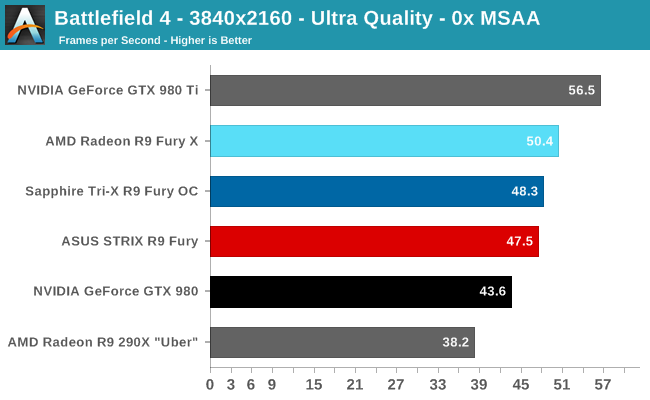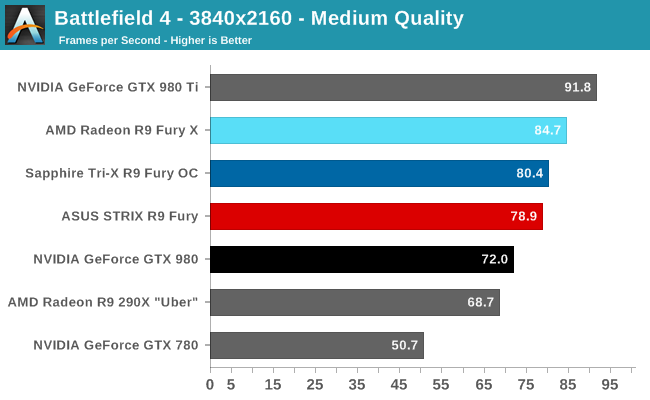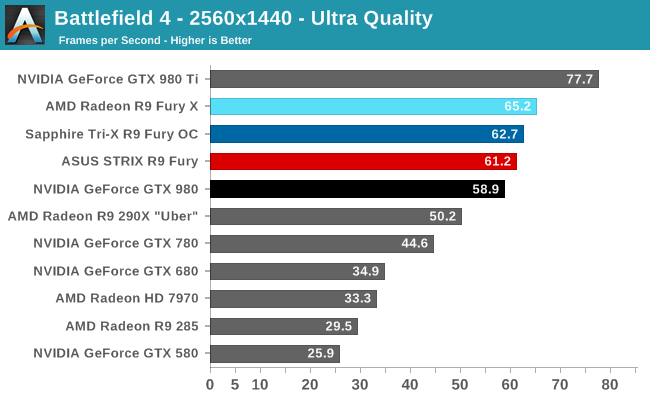The AMD Radeon R9 Fury Review, Feat. Sapphire & ASUS
by Ryan Smith on July 10, 2015 9:00 AM ESTBattlefield 4
Kicking off our benchmark suite is Battlefield 4, DICE’s 2013 multiplayer military shooter. After a rocky start, Battlefield 4 has since become a challenging game in its own right and a showcase title for low-level graphics APIs. As these benchmarks are from single player mode, based on our experiences our rule of thumb here is that multiplayer framerates will dip to half our single player framerates, which means a card needs to be able to average at least 60fps if it’s to be able to hold up in multiplayer.



When the R9 Fury X launched, one of the games it struggled with was Battlefield 4, where the GTX 980 Ti took a clear lead. However for the launch of the R9 Fury, things are much more in AMD’s favor. The two R9 Fury cards have a lead just shy of 10% over the GTX 980, roughly in-line with their price tag difference. As a result of that difference AMD needs to win in more or less every game by 10% to justify the R9 Fury’s higher price, and we’re starting things off exactly where AMD needs to be for price/performance parity.
Looking at the absolute numbers, we’re going to see AMD promote the R9 Fury as a 4K card, but even with Battlefield 4 I feel this is a good example of why it’s better suited for high quality 1440p gaming. The only way the R9 Fury can maintain an average framerate over 50fps (and thereby reasonable minimums) with a 4K resolution is to drop to a lower quality setting. Otherwise at just over 60fps, it’s in great shape for a 1440p card.
As for the R9 Fury X comparison, it’s interesting how close the R9 Fury gets. The cut-down card is never more than 7% behind the R9 Fury X. Make no mistake, the R9 Fury X is meaningfully faster, but scenarios such as these question whether it’s worth the extra $100.










288 Comments
View All Comments
Midwayman - Friday, July 10, 2015 - link
I'd love to see these two go at it again once dx12 games start showing up.Mugur - Saturday, July 11, 2015 - link
Bingo... :-). I bet the whole Fury lineup will gain a lot with DX12, especially the X2 part (4 + 4 GB won't equal 4 as in current CF). The are clearly CPU limited at this point.squngy - Saturday, July 11, 2015 - link
I don't know...Getting dx12 performance at the cost of dx11 performance sounds like a stupid idea this soon before dx12 games even come out.
By the time a good amount of dx12 games come out there will probably be new graphics cards available.
thomascheng - Saturday, July 11, 2015 - link
They will probably circle around and optimize things for 1080p and dx11, once dx12 and 4k is at a good place.akamateau - Tuesday, July 14, 2015 - link
DX12 games are out now. DX12 does not degrade DX11 performance. In fact Radeon 290x is 33% faster than 980 Ti in DX12. Fury X just CRUSHES ALL nVIDIA silicon with DX12 and there is a reason for it.Dx11 can ONLY feed data to the GPU serially and sequencially. Dx12 can feed data Asynchronously, the CPU send the data down the shader pipeline WHEN it is processed. Only AMD has this IP.
@DoUL - Sunday, July 19, 2015 - link
Kindly provide link to a single DX12 game that is "out now".In every single review of the GTX 980 Ti there is this slide of DX12 feature set that the GTX 980 Ti supports and in that slide in all the reviews "Async Compute" is right there setting in the open, so I'm not really sure what do you mean by "Only AMD has this IP"!
I'd strongly recommend that you hold your horses till DX12 games starts to roll out, and even then, don't forget the rocky start of DX11 titles!
Regarding the comparison you're referring to, that guy is known for his obsession with mathematical calculations and synthetic benchmarking, given the differences between real-world applications and numbers based on mathematical calculations, you shouldn't be using/taking his numbers as a factual baseline for what to come.
@DoUL - Sunday, July 19, 2015 - link
My Comment was intended as a reply to @akanateauOldSchoolKiller1977 - Sunday, July 26, 2015 - link
You are an idiotic person, wishful think and dreams don't make you correct. As stated please provide a link to these so called DX12 games and your wonderful "Fury X just CRUCHES ALL NVidia" statement.Michael Bay - Sunday, July 12, 2015 - link
As long as there is separate RAM in PCs, memory argument is moot, as contents are still copied and executed on in two places.akamateau - Tuesday, July 14, 2015 - link
Negative. Once Graphic data is processed and sent to the shaders it next goes to VRAM or video ram.System ram is what the CPU uses to process object draws. Once the objects are in the GPU pipes system ram is irrelevant.
IN fact that is one of AMD's stacked memory patents. AMD will be putting HBM on APU's to not only act as CPU cache but HBM video ram as well. They have patents for programmable HBM using FPGA's and reconfigurable cache memory HBM as well.
Stacked memory HBM can also be on the cpu package as a replacement for system ram. Can you imagine how your system would fly with 8-16gb of HBM instead of system ram?